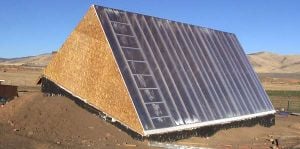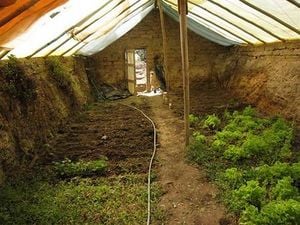(inserted text from corresponding OSE wiki page) |
mNo edit summary |
||
| Line 5: | Line 5: | ||
A greenhouse can be built by digging a hole in the ground and covering it with glass. This takes advantage of the heat stored in the earth during the cold season (warmth in winter, cooling in summer). It is an adaptation of the idea of [http://earthshelters.com/faq/passive-annual-heat-storage-definition/ passive annual heat storage (PAHS)] to the greenhouse. Therefore very suitable for climates with cold winters. At the depth of several meters, there is very little seasonal variation in temperature. The earth around the greenhouse structure has large thermal mass. | A greenhouse can be built by digging a hole in the ground and covering it with glass. This takes advantage of the heat stored in the earth during the cold season (warmth in winter, cooling in summer). It is an adaptation of the idea of [http://earthshelters.com/faq/passive-annual-heat-storage-definition/ passive annual heat storage (PAHS)] to the greenhouse. Therefore very suitable for climates with cold winters. At the depth of several meters, there is very little seasonal variation in temperature. The earth around the greenhouse structure has large thermal mass. | ||
The Benson Agriculture and Food Institute at Brigham Young University examined the concept in detail and has [http://www.bensoninstitute.org/Publication/Manuals/Walipini.pdf put together a manual] with specific designs | The Benson Agriculture and Food Institute at Brigham Young University examined the concept in detail and has [http://www.bensoninstitute.org/Publication/Manuals/Walipini.pdf put together a manual] with specific designs. These underground greenhouses are called ''"Walipini"'' (pit greenhouse) in South America. The Benson Institute's experiment was built in Bolivia, high up in the Andes where it gets ''really'' cold. Their greenhouse costs $250-$300 in materials and is designed to provide vegetables year-round for seven people. They recommend a minimum of 94 square feet (less than 8.75m<sup>2</sup>) of growing space per person. Some [http://undergroundaquaponics.blogspot.ca/2016/04/walipini-design-alterations-sugestions.html Walipini Design Alterations Sugestions] have been made. | ||
Mike Oehler of [http://undergroundhousing.com/ UndergroundHousing.com], described a similar concept in ''The Earth-Sheltered Solar Greenhouse Book'', available [http://www.downarchive.com/ebooks/313290-the-earth-sheltered-solar-greenhouse-book-by-mike.html here]. This is an adaptation from his earlier work on [[Underground Housing|underground housing]] for residential purposes. | Mike Oehler of [http://undergroundhousing.com/ UndergroundHousing.com], described a similar concept in ''The Earth-Sheltered Solar Greenhouse Book'', available [http://www.downarchive.com/ebooks/313290-the-earth-sheltered-solar-greenhouse-book-by-mike.html here]. This is an adaptation from his earlier work on [[Underground Housing|underground housing]] for residential purposes. | ||
==References== | ==References== | ||
Revision as of 16:46, 24 July 2016


A Walipini is an earth-sheltered cold frame.[1][2][3] It derives its name from the Aymaran languages.[4]
A greenhouse can be built by digging a hole in the ground and covering it with glass. This takes advantage of the heat stored in the earth during the cold season (warmth in winter, cooling in summer). It is an adaptation of the idea of passive annual heat storage (PAHS) to the greenhouse. Therefore very suitable for climates with cold winters. At the depth of several meters, there is very little seasonal variation in temperature. The earth around the greenhouse structure has large thermal mass.
The Benson Agriculture and Food Institute at Brigham Young University examined the concept in detail and has put together a manual with specific designs. These underground greenhouses are called "Walipini" (pit greenhouse) in South America. The Benson Institute's experiment was built in Bolivia, high up in the Andes where it gets really cold. Their greenhouse costs $250-$300 in materials and is designed to provide vegetables year-round for seven people. They recommend a minimum of 94 square feet (less than 8.75m2) of growing space per person. Some Walipini Design Alterations Sugestions have been made.
Mike Oehler of UndergroundHousing.com, described a similar concept in The Earth-Sheltered Solar Greenhouse Book, available here. This is an adaptation from his earlier work on underground housing for residential purposes.
References
Template:Stub Template:Attrib wikipedia
- ↑ "Walipini Construction (The Underground Greenhouse)" (PDF). The-meal.net. Retrieved 7 December 2014.
- ↑ "Pit Greenhouses". Inspirationgreen.com. Retrieved 7 December 2014.
- ↑ "Rob’s Modified Walipini". PermacultureNews.org. Retrieved 7 December 2014.
- ↑ "Build a $300 underground greenhouse for year-round gardening (Video)". TreeHugger. Retrieved 7 December 2014.